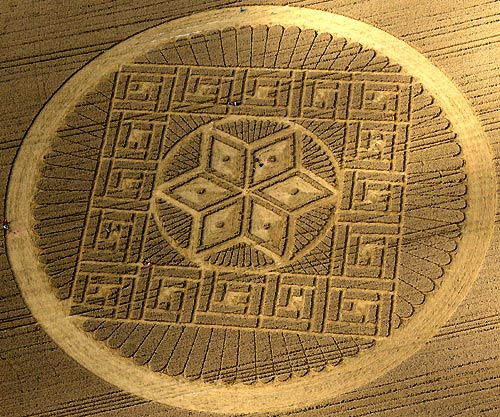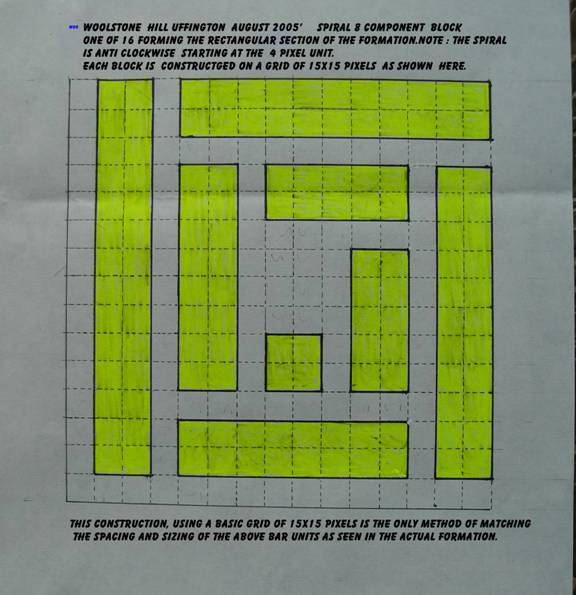|
Woolstone Hill Uffington August 2005. Diameter of outer ring. 366 ft.(111.6 mtrs.)
This is one of the most complex crop circle formations in terms of construction ever to occur in the fields of England. It is virtually a challenge to all those claiming or advocating that all crop formations are made by human teams. It says to us “So explain this one, replicate it faultlessly if you can in 5 hours of summer night darkness”. Or even perhaps in a week of daylight hours! Any would be ‘Replicators’ have the following tasks to carry out:- Stage 1. The 6 Central Diamond shapes. Make the 44mtr. dia. circle surrounding the diamonds and divide its circumference into 12 for the radial construction lines, (invisible). These lines are necessary to enable the positioning of the diamonds outer points, the diamond mid points and the exact centres of the diamonds. Next describe guideline circles, one of 22 meters. dia. and a further circle slightly larger, (both invisible,) for the 6 diamond half points and the 6 centers of the diamonds. Note: the radii for the diamond centers are not the same as for the diamond half points. Next lay the crop in precise swirls around the diamond centers to create the 24 walls of standing crop. Outline these walls by laying the crop in 24 straight lines on the outside of the walls. Stage 2: Set out the four tangents to the 44 meters. diameter circle at exactly 90 degrees to each other to form the inner edges of the large rectangle. Note: The width of the laid crop groove is critical and must be the same as all the other spacing grooves in the 16 small rectangular blocks to follow. Each of the four tangent grooves must now have its length divided into exactly three equal parts, these ‘thirds’ establish the dimensions of the sides of the 16 small ‘spiral blocks, and the overall size of the great rectangle. Stage 3: Create the 16 ‘spiral blocks’. This is the most difficult operation in the construction of the whole formation. The arrangement of the differently sized bars in the blocks forms a stylized spiral which is precisely constructed on a grid of 15 x 15 square pixels. See Block Diagram below. The blocks are positioned on the outside of the tangents in a sequence whereby each spiral is rotated 90 degrees from its neighbour, except in one instance where a block has been rotated 180 degrees, thereby breaking the sequencing. This results in two of the blocks looking identical, the left hand one being the error. They are in the top row, middle left of the illustration of the formation above. This ‘logic’ error has been noted by others but remains unexplained. It may be a deliberate mistake intended to draw attention to the complexity of the detail of the block construction removing any suggestion that a human source could have been involved. As the block diagram illustrates, the 15 x 15 invisible pixel grid would have to be established in some way to enable the precise sizing and spacing and the sequencing rotations of the spiral bars in the blocks, all done without the slightest error. This Stage 2.alone would be an impossible task for a human team, given the constraints of darkness and time involved. Multiplying the number of human operators to speed the operation would not seem to be an option. Co-ordination of effort would be virtually impossible and faults and errors would be inevitable, as we see so often in the known obviously manmade formations presented to us. It is worth noting that without the apparently deliberate mistake, the quarter turn sequencing of the blocks would continue unbroken in whichever direction considered, It would become perpetual.
Stage 4: Create the outer edge of the great circle of radius 55.8 meters. ( 183 ft.)., a difficult operation to do accurately due to the great tension required on the tape to overcome sag and damage to the standing crop. Also the anchor man at the circle centre would have problems in trying to avoid obvious damage to the crop lay at this point. There are no signs of such centre point damage. Next create the circle which coincides with the corners of the big rectangle and which carries the 78 divisions for the ‘feathers’. How would a human team produce these divisions as accurately as we see? 78 does not reduce to convenient factors, the simplest being 6 x 13, so while the radius of this circle could be used to divide the circumference into 6 parts, it is then difficult to divide each part into 13. The use of a theodolite or similar instrument would mean measuring intervals of 4.63 degrees between marker posts at the circle edge, a difficult operation in the dark at the distance involved. Errors would accumulate and result in obvious variations in width of the feathers at some point. Given the unlikely success, then comes the ‘very’ difficult bit, the feathers have to be cut by making very narrow laid grooves in perfect alignment with the circle centre but the grooves must not cut into either the great rectangle or the central diamond pattern. A ruler placed over any groove where visible, proves the alignment with the exact centre. A sight line would have to be made from here to a marker on the circle edge for the person making any groove to follow, but his journey is interrupted by the already completed parts of the formation. How would he, or assuming more than one man was used, jump the interruptions and preserve the accuracy? A superhuman technique is required here for this massive task, shuffling along in the dark one foot behind the other trying to avoid stumbling into the standing crop portions and stopping the groove at the right places. Stage 5: Finally, a comparatively easy, though tedious time consuming task. All the ends of the feathers must be rounded off to a uniform small radius. The distortions observed here and there are due to a coincidence with tram lines, so again care and accuracy is needed. There are a total of 141 (78 + 63 ) ends to be treated. A measuring device perhaps like a large pair of compasses would have been needed to fix a radial centre for each end. There are no marks in the crop to show some such device was used. Casual hand trimming cannot have been used. It could not be sufficiently accurate. So how was this operation done? The immensity of the total task in creating this Woolstone Hill formation within the constraints of the known circumstances at the time rules out a human operation. We know only too well that with one off crop circle projects, human teams make errors of precision, shape and symmetry which due to the nature of the crop medium cannot be undone or corrected and so are all too obvious to a discerning observer. Where we see virtual perfection of complex formations we should not accept the claims of debunkers who invariably offer no provable evidence of human involvement. They have their own agenda devoted to the discrediting of genuine crop circle research and supported financially by obscure background agencies. Jack Sullivan May 2012. |



